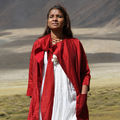Interviews
News Flash
CanopyStyle leaders throw weight behind viscose targets
05 Mar '20
2 min read

Pic: CanopyStyle
Following the Next Generation Action Plan released by not-for-profit environmental organisation Canopy at the World Economic Forum in Davos, 26 CanopyStyle brands and producers are launching a Next Generation Vision for Viscose. The vision supports investment in, creation, trial, and purchasing of rayon and viscose products made from low-impact alternative fibres.
Moving to circular alternatives like waste textiles, microbial cellulose or agricultural residues will help the fashion sector meet their climate and sustainability goals, while ending sourcing from ancient and endangered forests, Canopy said in a press release.
“Clothing made from Next Generation fabrics is not science fiction, it is already in stores and is an essential part of the fashion industry’s work to address our planet’s climate and biodiversity crises,” said Nicole Rycroft, Canopy’s founder and executive director.
“These brands and producers are showing real leadership. We know more will join this path in the coming months,” he added.
Supporters of the vision currently include EILEEN FISHER, ESPRIT, H&M, Inditex/Zara, Lindex, Marks & Spencer, Mara Hoffman, New Look, NEXT, Reformation, and Stella McCartney. The list also includes Tangshan Sanyou, the world’s fourth largest viscose producer that is now selling initial runs of viscose from 50 per cent post-consumer cotton.
Of the world’s five largest viscose producers, three already offer initial product lines with 20-50 per cent recycled cotton. There is an estimated 26 million tonnes of waste cotton and viscose textile ending in landfills each year, a small portion of which could be tapped to produce the entire 6.5 million tonnes of viscose currently generated annually.
Twenty per cent of all viscose production will be using Next Generation feedstock content, with a priority of replacing any remaining sourcing from ancient and endangered forests by the end of 2021. In 2030, half of all viscose is targeted to be made from Next Generation feedstocks.
This vision will support meeting global 2030 climate and biodiversity targets and would require just 17 new Next Gen mills and $3.4 billion in investment over the next decade—less than 1 per cent of global fashion sales annually.
Moving to circular alternatives like waste textiles, microbial cellulose or agricultural residues will help the fashion sector meet their climate and sustainability goals, while ending sourcing from ancient and endangered forests, Canopy said in a press release.
“Clothing made from Next Generation fabrics is not science fiction, it is already in stores and is an essential part of the fashion industry’s work to address our planet’s climate and biodiversity crises,” said Nicole Rycroft, Canopy’s founder and executive director.
“These brands and producers are showing real leadership. We know more will join this path in the coming months,” he added.
Supporters of the vision currently include EILEEN FISHER, ESPRIT, H&M, Inditex/Zara, Lindex, Marks & Spencer, Mara Hoffman, New Look, NEXT, Reformation, and Stella McCartney. The list also includes Tangshan Sanyou, the world’s fourth largest viscose producer that is now selling initial runs of viscose from 50 per cent post-consumer cotton.
Of the world’s five largest viscose producers, three already offer initial product lines with 20-50 per cent recycled cotton. There is an estimated 26 million tonnes of waste cotton and viscose textile ending in landfills each year, a small portion of which could be tapped to produce the entire 6.5 million tonnes of viscose currently generated annually.
Twenty per cent of all viscose production will be using Next Generation feedstock content, with a priority of replacing any remaining sourcing from ancient and endangered forests by the end of 2021. In 2030, half of all viscose is targeted to be made from Next Generation feedstocks.
This vision will support meeting global 2030 climate and biodiversity targets and would require just 17 new Next Gen mills and $3.4 billion in investment over the next decade—less than 1 per cent of global fashion sales annually.
Fibre2Fashion News Desk (DS)
Popular News
Leave your Comments
Editor’s Pick
































-Ltd..jpg?tr=w-120,h-60,c-at_max,cm-pad_resize,bg-ffffff)





.jpg?tr=w-120,h-60,c-at_max,cm-pad_resize,bg-ffffff)
.jpg?tr=w-120,h-60,c-at_max,cm-pad_resize,bg-ffffff)






